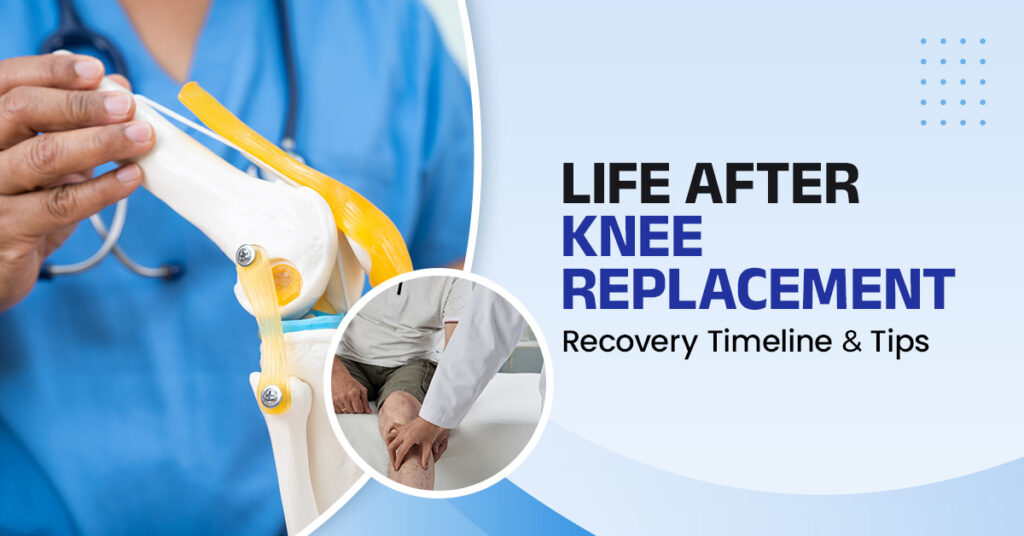For many people living with knee pain, even small daily activities like walking to the kitchen, getting up from a chair or climbing a few stairs can feel like a challenge. Over time, this pain can lead to frustration, loss of independence and even affect mental well-being.
Knee replacement surgery offers a way to regain mobility and return to a more active lifestyle. But patients often ask: What happens after surgery? How long will it take before I can walk normally?
This blog will guide you through the recovery timeline after knee replacement surgery, address common concerns, and share practical tips to make your healing process smoother and more predictable.
Weeks 1–2: Beginning Your Recovery
The first two weeks are the most crucial for setting the tone for your recovery. Most patients are encouraged to take their first steps (with support) within 24–48 hours of surgery. Early mobilization reduces stiffness and prevents complications like blood clots.
Here’s what to expect during this phase:
- Pain Management: Medications are prescribed to keep pain under control and help you participate in physiotherapy comfortably.
- Gentle Exercises: Simple exercises like ankle pumps, quad sets and gentle knee bends help improve blood flow and prevent stiffness.
- Wound Care: The incision site must be kept clean and monitored for any signs of infection.
Advice: Prepare your home environment in advance, keep frequently used items within reach, use a sturdy chair with armrests and arrange help for cooking and cleaning during the first two weeks.
Weeks 3–6: Building Strength and Confidence
By the third week, you will likely notice reduced pain and improved mobility. This is the phase where structured physiotherapy plays the most important role in your recovery.
Focus areas include:
- Physiotherapy Sessions: These help restore muscle strength and joint flexibility. Skipping sessions can delay recovery.
- Walking Practice: Gradually increase walking distance each day. A walker or crutches may still be required initially but will be phased out as you progress.
- Managing Swelling: Continue icing and elevating the leg when needed.
Advice: Set small, realistic goals like walking across the room without support or climbing a few stairs safely. Achieving these goals boosts confidence and motivation.
Weeks 7–12: Resuming Daily Activities
During this stage, most patients regain independence in performing daily tasks such as cooking, dressing, or light household work.
Key milestones in this phase:
- Walking Without Support: Most patients can walk independently.
- Improved Endurance: Standing for longer periods and taking short outdoor walks becomes easier.
- Reduced Pain and Stiffness: The knee continues to feel more natural as swelling subsides.
Advice: Stick to your exercise routine even when you feel better. Consistency now ensures long-term benefits from your knee replacement.
3–6 Months: Returning to a Normal Lifestyle
By three to six months, most patients experience a significant improvement in quality of life. Many return to activities like traveling, light sports (walking, swimming, cycling) and social events.
Focus during this phase:
- Strength Training: Continue exercises to maintain muscle strength.
- Weight Management: Keep your weight within a healthy range to reduce stress on the joint.
- Follow-Up Visits: Regular checkups with your surgeon ensure the knee is functioning well.
Advice: If you enjoy activities such as dancing, golf, or yoga, consult your doctor before resuming them. Proper guidance helps you avoid injuries.
Do’s and Don’ts After Knee Replacement
Do:
Follow your physiotherapy schedule diligently
Maintain good posture and use supportive footwear
Keep your surroundings safe to avoid accidental falls
Don’t:
Sit cross-legged or squat until advised by your doctor
Skip follow-up appointments
Return to running without advice or high-impact sports
Common Patient Concerns Addressed
- When can I drive again?
Most patients can drive 4–6 weeks after surgery, once they can bend the knee comfortably and react quickly. - Can I kneel or sit cross-legged?
Some patients can but it varies based on flexibility and type of surgery. Always confirm with your surgeon before trying. - What if I feel stiffness in the mornings?
Gentle stretches before getting out of bed can help. Stiffness usually improves as you become more active. - Will my knee feel completely normal?
Modern implants are designed to feel as natural as possible. With proper rehab, most patients report excellent function and minimal pain.
Your Recovery Journey Matters
Recovery after knee replacement is not just about the surgery, it is a combination of expert surgical care, structured rehabilitation and your active participation. Every patient’s journey is unique, but following the recommended timeline and tips can make your recovery smoother and faster.
With over 21 years of experience and more than 15,000 knee replacement surgeries, Dr. Saurin Shah a leading knee replacement surgeon in Ahmedabad and his team at Walk Well Joint Replacement Centre focus on providing end-to-end care from pre-surgical planning to post-operative physiotherapy helping patients regain mobility with confidence.
If you are exploring knee replacement as an option or are concerned about your recovery, consulting an experienced orthopedic surgeon can make a significant difference in your long-term outcome.

